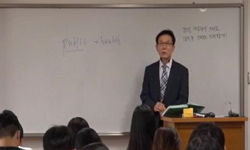This article deals with occupational diseases and the proof of causation with a focus on the debate in Germany. In occupational or work-related diseases, causation is a key criterion for their recognition. However, it is often very difficult to prove ...
http://chineseinput.net/에서 pinyin(병음)방식으로 중국어를 변환할 수 있습니다.
변환된 중국어를 복사하여 사용하시면 됩니다.
- 中文 을 입력하시려면 zhongwen을 입력하시고 space를누르시면됩니다.
- 北京 을 입력하시려면 beijing을 입력하시고 space를 누르시면 됩니다.

직업병과 인과관계 증명 -독일에서 논의를 중심으로- = Occupational Diseases and Proof of Causation - Focusing on Discussions in Germany -
한글로보기부가정보
다국어 초록 (Multilingual Abstract)
In Germany, occupational diseases are regulated by Section 9 of the German Social Code Book (SGB) Ⅶ, which is based on the “limited enumeration principle,” supplemented by the regulation of quasi occupational diseases. The definition of what constitutes an occupational disease can be divided into two categories:the first category is referred to as the 'strict constituent facts of an occupational disease,' and the second category is referred to as the 'open constituent facts of an occupational disease.' In the former category, the minimum dose of exposure is specified and proof is required; in the latter category, this is not the case. Section 9 (3) also provides for a presumption of causation in order to reduce the claimant's burden of proof.
In Germany, the Federal Social Court (BSG) rules that, in order to recognise an occupational disease, not only causation between the exposure and the disease, but also causation between the exposure and the performance of the work must be proved. This causation is showed in two stages:firstly, a causal link under the “but for test” (= conditio-sine-qua-non-formula) and secondly, a causal link under the “theory of the essential condition” (Wesentlichkeitstheorie). This contrasts with our practice of determining causation on the basis of “the proximate cause theory” (Adäquanztheorie). In particular, in two-step causal judgments, when there are competitive causes, it should be noted that causes that are not quasi-equivalent but numerically relatively low can also be important causes.
Finally, in Germany, the burden of proof is on the plaintiff to prove causation, and in order to lighten the plaintiff's burden of proof in lack of evidence, the standard of proof is interpreted as “proof of sufficient probability” rather than “proof beyond a reasonable doubt.” This is similar to our practice.
This article deals with occupational diseases and the proof of causation with a focus on the debate in Germany. In occupational or work-related diseases, causation is a key criterion for their recognition. However, it is often very difficult to prove causation. This is because occupational diseases often have a long incubation period or are caused by exposure to harmful factors over a long period of time, and are often caused not only by harmful work-related effects but also by pre-existing medical conditions or constitutional predispositions of casualties.
In Germany, occupational diseases are regulated by Section 9 of the German Social Code Book (SGB) Ⅶ, which is based on the “limited enumeration principle,” supplemented by the regulation of quasi occupational diseases. The definition of what constitutes an occupational disease can be divided into two categories:the first category is referred to as the 'strict constituent facts of an occupational disease,' and the second category is referred to as the 'open constituent facts of an occupational disease.' In the former category, the minimum dose of exposure is specified and proof is required; in the latter category, this is not the case. Section 9 (3) also provides for a presumption of causation in order to reduce the claimant's burden of proof.
In Germany, the Federal Social Court (BSG) rules that, in order to recognise an occupational disease, not only causation between the exposure and the disease, but also causation between the exposure and the performance of the work must be proved. This causation is showed in two stages:firstly, a causal link under the “but for test” (= conditio-sine-qua-non-formula) and secondly, a causal link under the “theory of the essential condition” (Wesentlichkeitstheorie). This contrasts with our practice of determining causation on the basis of “the proximate cause theory” (Adäquanztheorie). In particular, in two-step causal judgments, when there are competitive causes, it should be noted that causes that are not quasi-equivalent but numerically relatively low can also be important causes.
Finally, in Germany, the burden of proof is on the plaintiff to prove causation, and in order to lighten the plaintiff's burden of proof in lack of evidence, the standard of proof is interpreted as “proof of sufficient probability” rather than “proof beyond a reasonable doubt.” This is similar to our practice.
동일학술지(권/호) 다른 논문
-
- 한국법학원
- 이기수(Lee, Ki-Su)
- 2025
- KCI등재
-
- 한국법학원
- 정윤아
- 2025
- KCI등재
-
디지털서비스 이용자의 보호에 관한 연구 -디지털 입헌주의로부터의 시사점을 중심으로-
- 한국법학원
- 문의빈
- 2025
- KCI등재
-
인공지능의 구현을 목적으로 한 저작권법상 텍스트·데이터 마이닝 허용 논의와 관련한 옵트 아웃제 및 조건부 보상시스템 검토
- 한국법학원
- 신창환
- 2025
- KCI등재




 DBpia
DBpia






